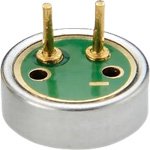Understanding the various classifications and characteristics of microphones is essential. Since its establishment, ECMIC has focused on the research and manufacturing of electroacoustic components, such as microphones, buzzers, and speakers. These products are widely used in audio entertainment, IoT devices, mobile devices, automotive technology, smart homes, and more.
Today, we’ll explore the differences between omnidirectional and unidirectional microphones.

Definition of Microphones
A microphone, also known as a mic or mike, is a sound-electric transducer device. It serves as the input terminal of audio devices, converting sound into an electrical signal, while a speaker does the opposite.
Classification of Microphones
Microphones can be classified based on their operating principles into types like carbon granule, electromagnetic, capacitive, electret condenser (ECMIC’s specialty), piezoelectric crystal, piezoelectric ceramic, and silicon dioxide types. They can also be categorized by size into various series such as Φ9.7, Φ6, Φ4.5, Φ4, and Φ3, each with different heights.
Additionally, microphones can be classified by directional patterns into omnidirectional, unidirectional, and bidirectional (noise-canceling) types, by polarization into diaphragm, back electret, and front electret types, and by connection method into regular soldering (L-type), PIN-footed (P-type), and concentric circle (S-type).



Introduction to Omnidirectional and Unidirectional Microphones
Omnidirectional microphones have equal sensitivity to sound from all directions, operating on the principle of pressure sensitivity. They are commonly used in situations requiring ambient sound capture, mobile sound sources, or presentations. However, they are susceptible to ambient noise.
Unidirectional microphones operate on the pressure gradient principle, receiving pressure from both the front and back through small holes in the microphone’s chamber, resulting in directional sensitivity and proximity effect.
Difference Between Omnidirectional and Unidirectional Microphones
Unidirectional Microphones
- Small pickup radius (around 30 cm), ideal for single-person use near the mouth to reject distant sounds.
- Commonly used as gooseneck mics, which focus on capturing sound from a single direction.
- Limited sensitivity range to avoid feedback issues.

Omnidirectional Microphones
- Large pickup radius (one to several meters), suitable for capturing multiple voices.
- High sensitivity, prone to picking up ambient noise, requiring noise reduction measures for better audio quality.
- Advantageous for simple wiring setups, suitable for small meetings, temporary conferences, and remote discussions.
- Generally do not support local amplification due to high sensitivity, which can lead to feedback issues.
ECMIC is at the forefront of innovation in the electroacoustics industry. Our commitment to cutting-edge technology and continuous investment in research and development have made us a magnet for top talent in the field. With state-of-the-art production facilities, advanced acoustic laboratories, and soundproof rooms equipped with the latest testing equipment, we ensure the highest quality in every product we manufacture.
Ready to experience the difference? Partner with ECMIC and elevate your audio solutions today.



